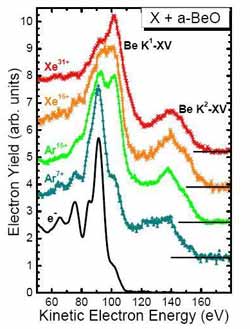Electrons Get Confused

The K1-XV-line-spectrum of beryllium-oxide. Picture: HZB/Schiwietz<br>
Scientists from Helmholtz-Zentrum Berlin (HZB) observed exotic be-haviour from beryllium oxide (BeO) when they bombarded it with high-speed heavy ions: After being shot in this way, the electrons in the BeO appeared “confused”, and seemed to completely forget the material properties of their environment.
The researchers’ measurements show changes in the electronic structure that can be explained by extremely rapid melting around the firing line of the heavy ions. If this interpre-tation is correct, then this would have to be the fastest melting ever observed. The researchers are publishing their results in Physical Review Letters (DOI: 10.1103/ Phys.Rev.Lett.105, 187603 (2010)).
In his experiments, Prof. Dr. Gregor Schiwietz and his team irradiated a beryllium oxide film with high-speed heavy ions of such strong charge that they possessed maximum smashing power. Unlike most other methods, the energy of the heavy ions was chosen so that they would interact chiefly with their outer valence electrons. As heavy ions penetrate into a material, there are typically two effects that occur immediately around the fired ions: the electrons in the immediate surroundings heat up and the atoms become strongly charged. At this point, Auger electrons are emitted, whose energy levels are measurable and show up in a so-called line spectrum. The line spectrum is characteristic for each different material, and normally changes only slightly upon bombardment with heavy ions.
As a world’s first, the HZB researchers have now bombarded an ion crystal (BeO), which has insulator properties, with very high-speed heavy ions (xenon ions), upon which they demonstrated a hitherto unknown effect: The line spectrum of the Auger electrons changed drastically – it became “washed out”, stretching into higher energies. Together with a team of physicists from Poland, Serbia and Brazil, the researchers observed distinctly metallic signatures from the Auger electrons emitted by the heated BeO material. The Auger electrons appeared to have completely “forgotten” their insulator properties. The researchers see this as clear evidence that the band structure breaks down extremely rapidly when the BeO is bombarded with heavy ions – in less than about 100 femtoseconds (one femtosecond is a millionth of a millionth of a millisecond). This breakdown is triggered by the high electron temperatures of up to 100000 Kelvin. In the long term, however, the material of the otherwise cold solid remains overall intact.
The HZB researchers’ results deliver strong evidence of ultra-fast melting processes around the firing line of the heavy ions. This melting is followed by annealing that deletes all permanent signs of the melting process. Prof. Schiwietz hopes to find other ionic crystals that exhibit the same rapid melting process, but in which the annealing process is suppressed. If any are found, then a conceivable application would be programming at femtosecond speeds.
The Helmholtz-Zentrum Berlin für Materialien und Energie (HZB) operates and develops large scale facilities for research with photons (synchrotron beams) and neutrons. The experimental facilities, some of which are unique, are used annually by more than 2,500 guest researchers from universities and other research organisations worldwide. Above all, HZB is known for the unique sample environments that can be created (high magnetic fields, low temperatures). HZB conducts materials research on themes that especially benefit from and are suited to large scale facilities. Research topics include magnetic materials and functional materials. In the research focus area of solar energy, the development of thin film solar cells is a priority, whilst chemical fuels from sunlight are also a vital research theme. HZB has approx.1,100 employees of whom some 800 work on the Lise-Meitner Campus in Wannsee and 300 on the Wilhelm-Conrad-Röntgen Campus in Adlershof.
HZB is a member of the Helmholtz Association of German Research Centres, the largest scientific organisation in Germany.
Media Contact
More Information:
http://www.helmholtz-berlin.de/All latest news from the category: Materials Sciences
Materials management deals with the research, development, manufacturing and processing of raw and industrial materials. Key aspects here are biological and medical issues, which play an increasingly important role in this field.
innovations-report offers in-depth articles related to the development and application of materials and the structure and properties of new materials.
Newest articles

Superradiant atoms could push the boundaries of how precisely time can be measured
Superradiant atoms can help us measure time more precisely than ever. In a new study, researchers from the University of Copenhagen present a new method for measuring the time interval,…

Ion thermoelectric conversion devices for near room temperature
The electrode sheet of the thermoelectric device consists of ionic hydrogel, which is sandwiched between the electrodes to form, and the Prussian blue on the electrode undergoes a redox reaction…

Zap Energy achieves 37-million-degree temperatures in a compact device
New publication reports record electron temperatures for a small-scale, sheared-flow-stabilized Z-pinch fusion device. In the nine decades since humans first produced fusion reactions, only a few fusion technologies have demonstrated…





















